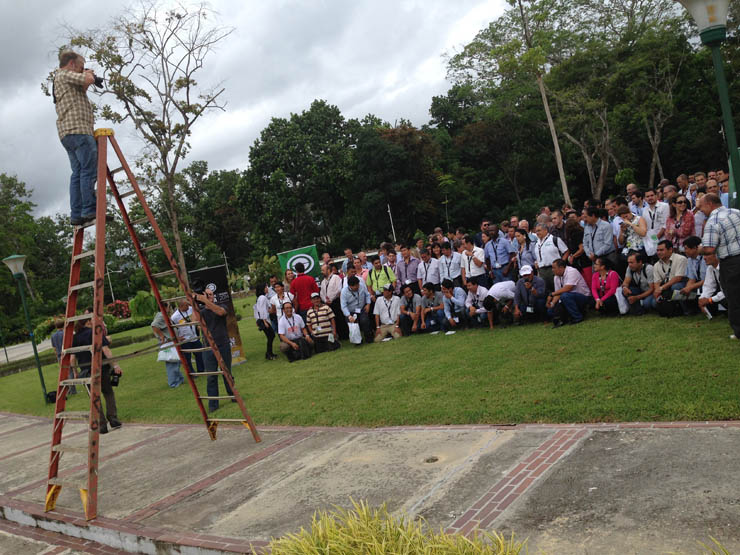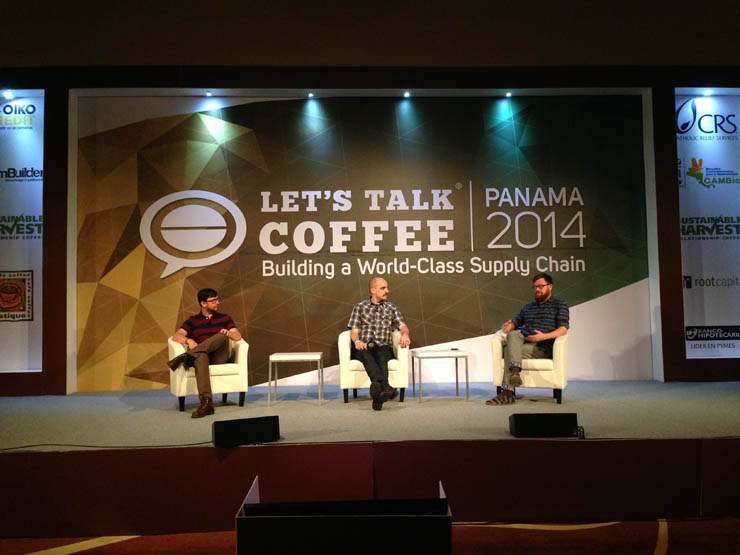Sustainable Harvest‘s 12th annual Let’s Talk Coffee conference is currently underway in Panama. We join Sprudge.com Associate Editor Liz Clayton from the event, where she’ll be a featured panel guest later today.
On the shores of Panama’s southern coast, a filmy mist of humidity forms across the screen of my laptop, while off in the distance, lines of ships begin to queue to transit the Panama Canal. I can’t be anywhere else but Let’s Talk Coffee 2014, a nearly 600-person-strong gathering of people concerned with coffee and the relationships it takes to make it.
Of the more than 30 countries represented at Let’s Talk Coffee Panama, from coffee producers to green buyers to roasters to baristas to nearly every other function within the coffee chain, each person here has something in common: an interest in helping good coffee not just get better, but be possible. What are the ingredients in that recipe beyond paying farmers well, riding out and responding to climate changes, and educating the end consumer? The relationships in between, and, as Sustainable Harvest founder and president David Griswold stressed, understanding one’s partner.
As the event kicked off, heavy issues came fast and furiously: when would Brazil’s crops be fully recovered from this year’s drought? (Projections say: without further climate change or activity, production growth will be resumed in Brazil by 2016.) What will the IMF‘s recently revealed miscalculations in growth mean to Latin American coffee producing countries? These are the kind of issues you can graph on a computer til the cows come home—or until they don’t. You really won’t know until you see the cow one day.
Specialty Coffee Association of America Executive Director Ric Rhinehart pointed out, in a morning panel on “Making Sense of Today’s Coffee Market”, the magnitude of importance on consumption patterns in today’s coffee-drinking generation. Millennials’ coffee consumption, said Rhinehart, differs greatly from that of the baby boom generation, noting that the biggest paradigm shift is in the way servings are viewed, and the understanding of price acceptance that follows from that. “If I ask my mother how much coffee costs, she says about $7 a can, and if I ask my son, he says $2.50 a cup.”
Pierre Ferrari, President and CEO of anti-poverty organization Heifer International (and formerly of Ben & Jerry’s and the Hot Fudge Venture Fund) gave a persuasive, down-to-earth perspective on income levels as they relate to “optimal emotional well-being”. What’s required per day, or per year, for a family in the United States to theoretically achieve this state can differ by a magnitude of 20 times the annual income of families in coffee-producing countries. How, Ferrari asks, do we close the gap? Incremental change, he stresses, is not enough. “The work that we do today,” Ferrari says, “is simply not sufficient.”
After a brief empanada break, we’re given a “warm, aromatic, fine-flavor welcome” to the convention within this convention, Let’s Talk Cocoa 2014. It’s pointed out to us by Catholic Relief Services‘ Jefferson Schriver that we’re at a “Darwinian moment” in climate change, where coffee farmers in particular are trying to figure out how to diversify. For some, cacao may be a viable option, able to provide additionally for farming families in a way that coffee farming on its own may strain to do. Numerous sessions during this week’s event will fall under the Let’s Talk Cocoa canopy, from Bean to Bar sessions to drinking chocolate tasting to agro-diversity.
Bringing home the tale of direct farmer-roaster-barista experimentation and great success were Laila Ghambari of Cherry Street Coffee House (and the reigning United States Barista Champion) Emilio Lopez Diaz of Cuatro M Cafes, and Phil Beattie of Dillano’s Coffee Roasters, who discussed the secrets to their competition success earlier this year. “A roaster is only as good as the feedback they get on the way they’re roasting,” avowed Beattie, though Ghambari tipped her hat to strategies like reading up on sports psychology and writing “I am the United States Barista Champion” over and over again in a notebook in between hours at the training lab. Above all, the victory felt truly shared, driving home the essence of the coffee chain’s emotional as well as meritocratical meaning: “Every step of the way, it was all three of us,” said the champion.
A look at two different, mid-sized-market strategies for cold brew coffee followed suit at the end of the day in “Let’s Talk Cold Brew”, where the workings behind Blue Bottle’s New Orleans Style cartoned cold brew and Portland Roasting Coffee‘s custom cold brew for Burgerville were revealed. Afterwards, the crowd stampeded out to down samples of New Orleans, brought down by the Blue Bottle crew in refrigerated luggage. It wasn’t quite like Oprah announcing that everyone in the audience got a free car, but let’s just say the reaction was similar.
And finally, the second annual HarVees gala awards ceremony landed. Whether you came to watch your favorite coffee roaster take home the first ever roasters’ awards, to gawk at Ken Davids heretofore unknown multi-instrumental percussive talents, to reminisce about and honor your favorite former Keurig Green Mountain employees, to cheer on your favorite relationship farm or simply to enjoy the moment when Stephen Vick and Phil Beattie rubbed beards onstage, the night was sure to have satisfied at least some part of you. Perhaps the part of you that adores a gala.
What’s on for tomorrow? An update on the Geisha variety post-peak-stardom, the TOM’S one for one model, a new species of coffee, and more cocoa vying for coffee lover’s distracted attentions. Possibly also more “Plantains in Fascination” at breakfast, but no promises.
Liz Clayton is the Associate Editor at Sprudge.com, and helms our NYC desk. Read more Liz Clayton on Sprudge.






